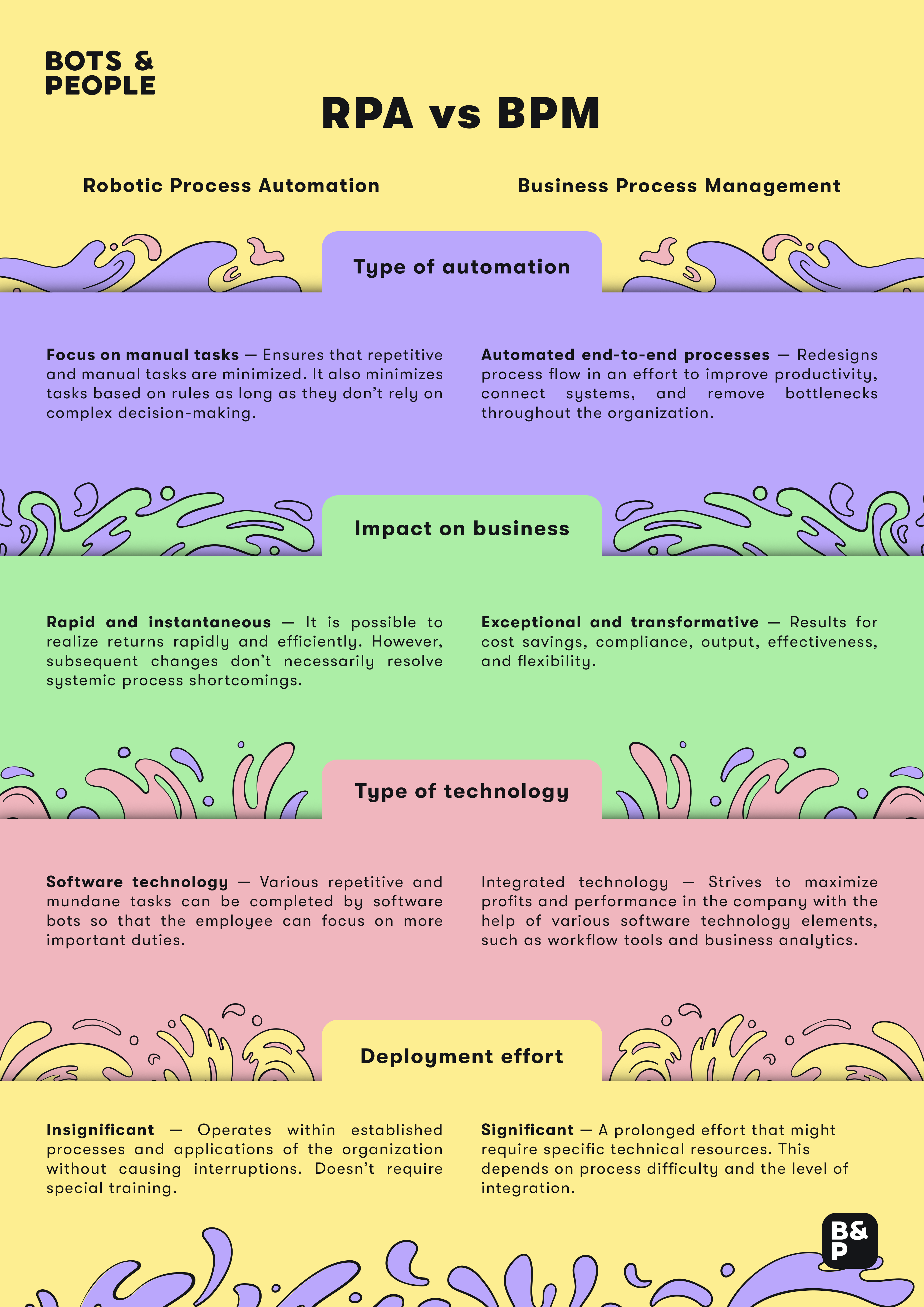To remain competitive in the long term and retain their customers, companies must constantly improve. Digitization, automation and digital transformation are important buzzwords for innovative company strategies these days. Robotic Process Automation (RPA) and Business Process Management (BPM) are designed to help optimize business processes. But how do these approaches fit into a holistic strategy?
Info: RPA is only one aspect of process automation. Other important technologies for a holistic automation strategy are, for example, Process Mining, iPaaS, machine learning, AI, etc. However, the following article will focus on RPA and BPM.

What is Business Process Management (BPM)?
Business Process Management (BPM) - also known as Business Process Management (BPM) - is designed to optimize business processes by making them more flexible, transparent and, above all, more efficient. The aim is to make optimum use of the company's capacities, to improve all processes and to coordinate them with one another. Business process management is therefore not a specific software, but a holistic, strategic approach that manages company processes and links human and automated activities in an ideal sequence. It is not about a quick implementation, but a long-term, profitable strategy.
What is Robotic Process Management (RPA)?
With the help of robot-controlled process automation, repetitive, digital business processes are to be automated by software robots. Routine processes are thus completed faster, more efficiently, more cost-effectively and with fewer errors. Employees can focus on the core tasks of the business and do not have to deal with tedious, monotonous tasks.
Typical activities that RPA tools can handle include sorting data, filling out forms and spreadsheets, sending automated mails or retrieving information, for example from social media. Robotic Process Automation is quick to implement and easy to customize. Furthermore, well-implemented RPA helps companies maneuver through crises, such as the Corona pandemic, and minimize damage.
Both approaches aim to make company processes more efficient and optimize them. So where is the difference?
RPA vs. BPM
In short, the approaches achieve efficiency in different ways. BPM restructures processes and optimizes the business structure as a whole, while RPA automates existing processes. Business Process Management thus forms a kind of blueprint in which all processes are optimally integrated and improves the output of the company through a new optimized value chain.
Robotic Process Automation can and should be a building block of this chain, with bots taking over individual activities and automated as well as human tasks complementing each other in a common workflow. Robotic process optimization can be a part of BPM, but it does not replace it. Once a process is automated, it can be analyzed and continuously improved using business process management. RPA is rather a tool with which the blueprint is implemented.
The common goal: Efficiency
Both Business Process Management and Robotic Process Automation are ultimately intended to reduce a company's effort, make optimum use of capacities, save costs and deliver optimized output. They have the same goal: to bring people and technology together and keep employees and customers happy. The two technologies are different in themselves, but they do not compete, but complement each other.
Scenario: BPM and RPA in the banking industry
Let's imagine that a prospective customer wants to become a new customer of a bank. Intelligent process management directly triggers a standardized workflow. An RPA bot processes the request and, after a check, creates the approval. Then, based on the established workflow, a bank account is automatically opened and access data is created. The customer then receives an automated confirmation email. The process is transparent, error-free and efficient.
Conclusion: Using RPA and BPM together
Robotic Process Automation and Business Process Management complement each other perfectly and can be integrated seamlessly. While robotic process automation initially streamlines workflows, making them cheaper and more reliable, good business process management arranges the value-adding work steps transparently as well as optimally. In this way, the full potential and all the benefits of digitization and automation can be exploited. An intelligent workflow can trigger intelligent RPA bots and vice versa. Well-structured processes should implement automated work steps.
Without optimal, automated processes, even good management is useless, and conversely, good BPM cannot achieve great results if the processes themselves are tedious and error-prone. It is the combination of both approaches that makes for success and provides the basis for an innovative and sustainable digital transformation.
%20and%20Business%20Process%20Management%20(BPM)-%20What%20is%20the%20difference%3F.png)








